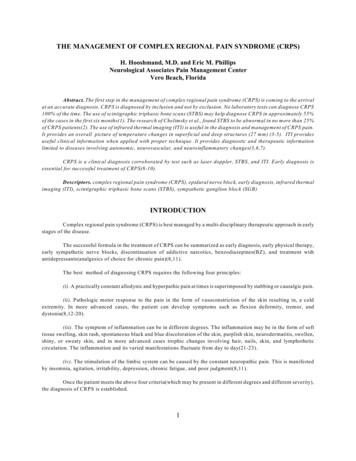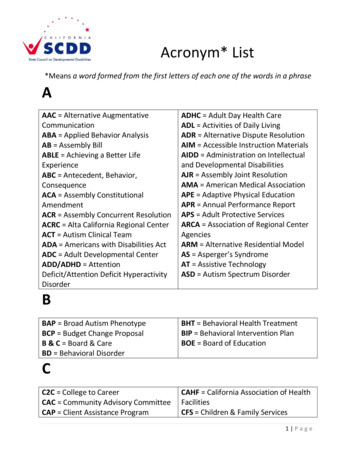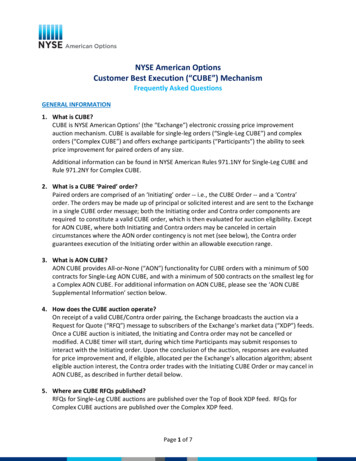
Transcription
THE MANAGEMENT OF COMPLEX REGIONAL PAIN SYNDROME (CRPS)H. Hooshmand, M.D. and Eric M. PhillipsNeurological Associates Pain Management CenterVero Beach, FloridaAbstract. The first step in the management of complex regional pain syndrome (CRPS) is coming to the arrivalat an accurate diagnosis. CRPS is diagnosed by inclusion and not by exclusion. No laboratory tests can diagnose CRPS100% of the time. The use of scintigraphic triphasic bone scans (STBS) may help diagnose CRPS in approximately 55%of the cases in the first six months(1). The research of Chelimsky et al., found STBS to be abnormal in no more than 25%of CRPS patients(2). The use of infrared thermal imaging (ITI) is useful in the diagnosis and management of CRPS pain.It provides an overall picture of temperature changes in superficial and deep structures (27 mm) (3-5). ITI providesuseful clinical information when applied with proper technique. It provides diagnostic and therapeutic informationlimited to diseases involving autonomic, neurovascular, and neuroinflammatory changes(3,6,7).CRPS is a clinical diagnosis corroborated by test such as laser doppler, STBS, and ITI. Early diagnosis isessential for successful treatment of CRPS(8-10).Descriptors. complex regional pain syndrome (CRPS), epidural nerve block, early diagnosis, infrared thermalimaging (ITI), scintigraphic triphasic bone scans (STBS), sympathetic ganglion block (SGB)INTRODUCTIONComplex regional pain syndrome (CRPS) is best managed by a multi-disciplinary therapeutic approach in earlystages of the disease.The successful formula in the treatment of CRPS can be summarized as early diagnosis, early physical therapy,early sympathetic nerve blocks, discontinuation of addictive narcotics, benzodiazepines(BZ), and treatment withantidepressants(analgesics of choice for chronic pain)(8,11).The best method of diagnosing CRPS requires the following four principles:(i). A practically constant allodynic and hyperpathic pain at times is superimposed by stabbing or causalgic pain.(ii). Pathologic motor response to the pain in the form of vasoconstriction of the skin resulting in, a coldextremity. In more advanced cases, the patient can develop symptoms such as flexion deformity, tremor, anddystonia(8,12-20).(iii). The symptom of inflammation can be in different degrees. The inflammation may be in the form of softtissue swelling, skin rash, spontaneous black and blue discoloration of the skin, purplish skin, neurodermatitis, swollen,shiny, or sweaty skin, and in more advanced cases trophic changes involving hair, nails, skin, and lymphotheticcirculation. The inflammation and its varied manifestations fluctuate from day to day(21-23).(iv). The stimulation of the limbic system can be caused by the constant neuropathic pain. This is manifestedby insomnia, agitation, irritability, depression, chronic fatigue, and poor judgment(8,11).Once the patient meets the above four criteria(which may be present in different degrees and different severity),the diagnosis of CRPS is established.1
MANAGEMENT OF CRPSIn the treatment of CRPS the administration of a multi-disciplinary management approach discussed below isquite helpful in the management of CRPS patients.(i). Detoxification: By the time the patient is referred to a pain clinic for the management of CRPS, they arealready on a series of addicting medications. The use of addicting medications should be discontinued and the patientshould be detoxified at the onset of treatment.(ii). Detoxification from addicting Benzodiazepams: M ost commonly, such patients have been treated on along term basis with medications such as Valium as a muscle relaxant, Xanax, Ativan, or Tranxene as anxiolytic, Halcion,Dalmane, or Restoril as a sedative.Realizing that there are two forms of benzodiazepams available which are not addicting (they do not suppressthe cerebral endo-benzodiazepams formation). These two medications can be used to replace the addictingbenzodiazepams. These consist of Klonopin (Clonazepam), and Serax. The patient can be withdrawn quite rapidly inthe matter of five to seven days as long as Klonopin is used in generous doses to prevent withdrawal. In the case ofHalcion and Valium, it may take up to two to three weeks to achieve the same goal because of their strong potential ofdependence.(iii). Detoxification from addicting narcotics: Invariably, such patients have been exposed to medicationssuch as Lortab, Lorcet, Percodan, Percocet, Demerol, and a large list of other Morphine agonists which can suppress thecerebral endorphines on a long term basis.Realizing that no CRPS patient will see any type of improvement as long as their pain is not under control, andrealizing that no CRPS patient will get better as long as the cerebral endorphines are absent, the patients should be “coldturkey” withdrawn from the above mentioned addicting narcotics. This immediate withdrawal can be achieved byproviding the patient with Morphine antagonists, non-addicting type of narcotics that provide complete pain reliefwithout withdrawal complications enabling the patient to discontinue the strong narcotics that they have been on. Thisis achieved by treatment with Stadol (nasal spray is preferred to IM form) alternated with one to two tablets of Ultramevery four hours as needed. Between there two non-addicting strong narcotics, the patient will not suffer from withdrawalpain. If the patient for any reason cannot take one or the other of the above-mentioned two medications, then there arealternative analgesics with the same characteristics as the above-mentioned medications. These consist of Nubain orBuprenorphine (Buprenex).Realizing that Stadol is not even a controlled substance and realizing that it has only the potential abuse ofpsychological rather than physical nature, the patient should sign a contract that they will not seek pain medication fromanother source. In addition, even if the patient tries to abuse the system and tries to take the old addicting narcotics alongwith Stadol, then they will become quite nauseated and that gives the clue to the clinician regarding purposeful drugabuse in early stages.(iv). Treatment with new er Antidepressants: The treatment of choice for CRPS is the use of antidepressants.Every CRPS patient should be started on antidepressants from the beginning of their course of treatment. The patientshould be educated that the use of antidepressants is not for the purpose of counteracting depression. Antidepressantshave three major functions which consist of first of all providing analgesia, secondly providing natural sleep, and thirdlyimproving cerebral function to better control depression.The antidepressant of choice in order of preference for CRPS patients is Trazodone (which provides excellentREM sleep and accelerates recovery along with providing excellent analgesic effect), Prozac, Paxil, and Desipramine.2
The older tricyclic antidepressants such as Elavil and Tofranil should be avoided due to the fact that they cancause weight gain, inactivity due to aggravation of fatigue, and can aggravate cardiac arrhythmia.The patient’s compliance should be monitored with the help of obtaining serum levels of antidepressants. Thedosage of the medication should be adjusted according to the patient’s tolerance and their sleep pattern. The dosage ofantidepressants is quite variable from patient to patient.(v). Treatment with muscle relaxants: The constant component of CRPS is hypertonicity of the muscles inthe form of vasoconstriction, flexion spasm, or movement disorder(8,12-20). It is imperative to treat the patient withmuscle relaxants. The use of addicting muscle relaxants such as Soma should be avoided. Soma is metabolized in thebody and is transformed to meprobamate which is quite addicting and causes withdrawal with recurrence of musclespasms. Flexeril which some hoe has the reputation of being an antidepressant, is quite depressing and aggravates fatigue.It is quite effective in somatic type of muscle spasm, but not the sympathetic type.The ideal muscle relaxant which works quite selectively on anterior lateral horn cells of the spinal cord isLioresal(Baclofen). This medicine should be started in small doses and gradually increased to a larger dose. The limitingfactor is nausea. Once the patient develops nausea, then the dosage should be cut down by 5-10 mg and not increasedany further.Another effective muscle relaxant is Norflex. If the patient has muscle spasms along with jerky movement anddystonic motion of the extremity, the use of anticonvulsants such as Klonopin, Neurontin, Tegretol, Depakene andTrileptal may be beneficial.After achieving enough relaxation of the muscles in the extremity, the use of assistive devices such as crutches,wheelchair, braces, canes, and walkers should be discontinued. As long as the extremity is inactive due to the use ofassistive devices or due to the application of a cast, the “sleeping nociceptive nerve fibers” become activated causingmore inflammation and deep pain.PITFALLS IN THE MANAGEMENT OF CRPSThe lack of a multi-disciplinary therapeutic approach can cause major pitfalls in the management of CRPS.Depending on the specialist who first starts treating the patient, the treatment method is eschewed toward the role of thatspecialty. This simple neuropathologic fact has become a point of contention and argument among physicians. This hasdeprived a lot of patients from proper treatment just because in the chronic stages of their pain, it is not purelysympathetic in nature.The more chronic the disease, the more the treatment should be addressing the control of both sympathetic andnon-sympathetic pain.Also, the lack of understanding of the disease can cause major pitfalls in the treatment and management ofCRPS.USEFUL TOOLS IN THE MANAGEMENT OF CRPSThe use of infrared thermal imaging (ITI) can facilitate early diagnosis of CRPS, and can achieve a higherrecovery rate among CRPS patients by virtue of early diagnosis of the disease. CRPS cannot be accurately diagnosedby a single test. CRPS is a clinical diagnosis when the following four principles are met (7-9,24-26):3
(i). Neuropathic, hyperpathic, or causalgic pain;(ii). Vasomotor disturbance, flexor spasm, or tremor;(iii). Inflammation at some point in the course of the disease;(iv). Limbic system dysfunction in the form of insomnia, agitation, depression, and poor memory (7,11,27).Tests such as ITI are mainly helpful to obtain information regarding the nature and extent of the disease, andto guide the clinician in proper management of pain (7,8).ITI is helpful in identifying the areas of thermosensory nerve damage, and as well as diagnosing thephenomenon of CRPS spread.Another commonly applied test of choice for the diagnosis of CRPS is the scintigraphic triphasic bone scan(STBS). Lee and W eeks, in their meta-analysis of STBS showed this test to be positive in no more than 55% of CRPSpatients (1, 28). Chelimsky et al., found STBS to be abnormal in no more than 25% of CRPS patients(2).The use of anatomical tests such as magnetic resonance imaging (MRI), computed tomography (CT), andphysiological tests such as electromyography (EMG) and nerve conduction velocity (NCV) tests have been the maindiagnostic tools applied in the management of somesthetic (somatic) pain. The above tests usually are not informativein the diagnosis of neuropathic pain(3).The neurovascular involvement in neuropathic pain requires tests such as ITI and Quantitative sudomotoraxon reflex test (QSART) that address the autonomic (e.g., thermal) changes for a more accurate diagnosis andtreatment(3).NERVE BLOCKSThe use of sympathetic ganglion blocks (SGB) is not helpful in the treatment of late stages of CRPS. This isbecause the patient’s pain is not sympathetically maintained pain (SMP), but the pain is sympathetically independent pain(SIP). In the early stages of the disease, when the pain is SMP in nature, SGB temporarily help calm down the disease.They are mainly used as a diagnostic tool rather than a therapeutic tool. In late stages of the disease, the use of SGB canbe more harmful by being traumatic to the sympathetic nervous system(11,29,30).In contrast, in late stages of CRPS, the only form of nerve blocks that are helpful and improve the pain areepidural, caudal, and paravertebral nerve blocks. These blocks have nothing in common with SGB. The SGB is doneby inserting a needle into the sympathetic ganglion. Each time this is done, several nerve cells are destroyed andexcessive repetitive SGB can cause “virtual sympathectomy” due to permanent damage to the sympathetic ganglia(3,6,7,11).The use of an epidural nerve block is the last resort type nerve block in patients with late stage CRPS. Thereason for administration of epidural and paravertebral nerve blocks is the fact that the pathology is chronic and isaffecting both sympathetic and somesthetic systems. These blocks help relieve the pain and improve the circulation inthe target area. This block is done by insertion of the needle into the epidural space (the space between the spinal cordand spinal canal). This is done under x-ray guidance. After the epidural space is identified, a combination of 4/5Marcaine local anesthetic and a minuscule amount of Depo-Medrol is injected in the epidural space. The DepoMedrol itself consists of a large inert and innocuous protein attached to a small amount of Methylprednisolone. Theuse of local anesthetic Marcaine and a small amount of a corticosteroid helps relieves the pain and reduces theinflammation.4
Because of the heavy molecule of protein attached to the corticosteroid, the blood circulation cannot readilyabsorb the Depo-Medrol . As a result, the beneficial effect of pain relief and anti-inflammation lasts approximatelytwo to three months. During the same period of time, physical therapy, massage therapy, and other treatments areapplied. In 90% of such patients do not need more than one complete course of nerve blocks. In 10% of the patientswho have been quite chronic and have had permanent nerve damage may need a reinforcement course of nerveblocks every three to four months.The side effects of this treatment are nil or negligible. The molecule of protein does not allow thecorticosteroid to spread to other organs of the body, and helps the beneficial effect of the treatment to last up to twoto three months.If the chronic, complicated patients are not treated with epidural blocks, the patient becomes inactive andimmobilized due to severe pain. In contrast, these blocks provide relief lasting up to three months as well as reducingthe neuroinflammation of CRPS. The prolonged inactivity and bed rest are the two cardinal sins in the managementof CRPS, and are counteracted with these blocks.If we go according to current concepts of diagnosis and management of CRPS, the patients are doomed tobe in severe chronic pain and are loaded with strong narcotics that make them even more inactive. This is the mainreason for the very high percentage of failure in the management of CRPS.On the other hand, in our study of 824 CRPS patients, we have found that more than 50% of the patientsreturn to work after they have been detoxified and treated with epidural and paravertebral nerve blocks versus lessthan 20% treatment success in patients who were not treated effectively or were treated with unnecessary surgicalprocedures(11).MANNITOL IN THE TREATMENT OF CRPSIn, 1969 and 1972 the research by my colleagues and I showed the efficacy of the use of Mannitol, incounteracting intracellular edema(31,32).Over the past decade in our clinic, we have noted the beneficial effect of I.V. Mannitol in neuroinflammation.This is especially true in patients suffering from post- herpetic neuralgia, CRPS, and other forms of neuropathic pain.The common denominator in the various neuropathic pain is involvement of thermoreceptor sensory nerves and thesympathetic system at some stage of the disease. The sympathetic nervous system has three main functions. (I). Thermalregulation; (ii). Control of vital signs; (iii). Regulation and modulation of the immune system function. In the neuropathicpain patients, it is not that unusual for the dysfunctional immune system to cause neuroinflammation accompanied byintercellular and axonal edema. If such patients are treated with plasma diuretics such as Hydrochlorothiazide or Lasix,these diuretics reduce the plasma volume which can have the potential of causing edema ex-vacuole and aggravate theneuroinflammatory edema.The use of I.V. M annitol (which is an inert sugar, and is a selective strong diuretic) selectively helps counteractneuroinflammation and reduces the intracellular edema of CRPS. On the basis, in our clinic as well as Doctor Veldmanand his colleagues from the Netherlands have applied I.V. Mannitol to counteract the neurogenic edema of CRPS (33).This neurogenic edema is especially more prominent in patients who have undergone surgery for sympathectomy, infusionpump treatment, and spinal cord stimulator (SCS). At times the neuroinflammation is severe enough to cause suchsymptoms as skin rash and neurodermatitis as well.I.V. M annitol is very well tolerated. The only contraindications are in patients who have practically total renalfailure and in patients who already have a dead space of an intracerebral hemorrhage or necrotic brain tumor, which cancause entrapment of the Mannitol in the dead space.As long as the patient has normal renal clearance (no protein in the urine), the I.V. Mannitol is quite safe in thetreatment of CRPS. As the Mannitol has a tendency to crystallize, the IV should be applied in 1-1 ½ hours. If the IV dripis prolonged up to 4-6 hours, there is the risk of crystallization of the M annitol. Certainly, a filter should help prevent anysuch risk as well. The usual dose is 100gm Mannitol in 500cc D5W (depending on the patients weight). This treatmentcan be done on an out patient basis.5
Usually, it only takes one to three treatments of I.V. Mannitol to help reduce the neuroinflammation ofCRPS. Also, I.V. Mannitol treatment is quite successful and would help eliminate the necessity for unnecessarysurgery in CRPS.PHYSICAL THERAPY"There have been references in the literature that physical therapy can aggravate the patient’s pain. Yet in everyoutline of treatment for CRPS, the use of physical therapy is emphasized. These two statements seem to be contradictory."Both statements are absolutely true. Excessive exercise and physical therapy that causes fatigue, pain, and distressto any part of the body, only flares-up aggravates the inflammation and pain of CRPS. On the other hand, the commonestaggravators of CRPS are bed rest, inactivity, application of ice, and the use of assistive devices (8,34). In CRPS, the besttreatment is eustress and not distress (8).Distress refers to the stress of prolonged bed rest and inactivity. Like any other machine, prolonged idling of thebody is distressful and causes damage to the body. Especially in CRPS, the prolonged bed rest results in aggravation ofpain and insomnia. These patients also suffer from severe, chronic insomnia due to the constant allodynic pain as well asdue to the aggravation of constriction of blood vessels secondary to inactivity. One of the earliest signs of CRPS is arestless night with the patient constantly being fidgety and changing position all night as well as having to get up and walkto get some relief.The second form of distress is too much exercise, and prolonged physical therapy.The CRPS patient has to learn that they will have pain with too much exercise, and the patient will have morepain without exercise. The patient will have to find a happy medium. The patient will have to rest and exercise frequently.Three days a week in the P.T. Department is not enough. The patient should continue the instructions of the physicaltherapist from morning to night with equal periods of rest and exercise. The patient should learn from the human heartwhich beats approximately once a second for 80 to 90 years without taking a vacation. The reason is the heart beats halfa second and rests half a second. The same principle should apply to physical therapy in CRPS.MASSAGE THERAPYMassage therapy is practically indispensable for the treatment of CRPS, especially if the patient isundergoing trigger point injections, occipital nerve blocks, and paravertebral nerve blocks. Applying massage therapyimmediately after having the above-mentioned nerve blocks disseminates the irritating chemicals (e.g., nitric oxide(NO), substance P, and calcitonin gene-related peptide (CGRP)away from the area that the nerve block insertion hasreleased the encapsulated chemicals and thus helps the elimination of the irritating chemicals by massage as well asapplication of moist heat. This is similar to trying to clean a swimming pool that has not been touched for a year.Obviously, the pool is full of residuals of chemicals that have been accumulated in the pool. It is not enough topartially clean the toxic chemicals, but it also needs the flushing of the chemicals out of the pool. The massage doesthe job of flushing of the chemicals out of the encapsulated areas making the chemicals accessible to capillaries,which absorb the chemicals and excrete them through the kidneys.PROPRIOTHERAPYPropriotherapy refers to the patient applying physical therapy onto themselves. For example, one of the besttreatment modalities for pain is treatment of allodynia (proprioceptive touching and applying massage) applied by thepatient in the form of gentle massage to the skin. If another person tries to do the massage in the same sensitive area,the pain may get worse, but the patient can usually perform the proprioception with far less pain. Application of Emlacream(lidocaine 2.5% and prilocaine 2.5%)also helps. This is not a sign of malingering or anything like that. It isnoted in animals suffering from neuropathic pain of CRPS that animals avoid any contact with people or otheranimals. On the other hand, when the pain is severe, cats or dogs try to get relief by licking and even gently biting theextremity. W e don't expect any patient to bite their extremity, but otherwise proprioceptive therapy is very effective.The patient should use the propriotherapy for treatment of allodynia, as well as for treatment of inactivity causingdeep pain.6
AVOIDANCE OF SURGERYThe major contributors to failure of CRPS management are application of ice, the use of addicting medications,bed rest, inactivity, the application of a cast, and the performance of unnecessary operations(8,11,34).The commonest forms of surgical procedures that cause permanent damage and permanent intractability of CRPSare: Carpel tunnel surgery, tarsal tunnel surgery, rotator cuff surgery, ulnar nerve decompression, surgical exploration ofthe knee, neuroma, or ankle, thoracic outlet syndrome surgery, or removal of a bulging disc or herniated discs in thedistribution of spasm and pain secondary to CRPS.Realizing that CRPS is invariably accompanied by different degrees of inflammation, it is not at all uncommonfor the patient to have a clinical picture simulating carpal tunnel or tarsal tunnel syndrome. Instead of operating on thepatient, the best things to do are to use epsom salt with warm water, nerve blocks, and I.V. Mannitol to help take awaythe inflammation.The clinician should be reminded that it is not the so-called entrapment neuropathy which is the cause of CRPS.The reverse is invariably the case.Other surgical treatment methods such as sympathectomy is invariably a failure. Its application should be limitedto the patients who have less than five years of life expectancy(8). In such late stages of CRPS, the nervous system haslost its plasticity and cannot respond properly to surgical sympathectomy (11,35). More over, the disease has spread, toother parts of the body and a regional sympathectomy will not be of any benefit to the patient (3,11,36-39).Chemical sympathectomy (Alcohol blocks) which are chemical blocks in the form of phenol, alcohol, etc., arethe most dangerous and destructive forms of nerve blocks.The use of alcohol blocks, sympathectomy, or neurectomy (cutting nerve fibers) only adds assault to the injury.Such destructive procedures relieve the pain for a few weeks to a maximum two months, only for the pain to return withmore intensity and in a larger area of the body.The use of radiofrequency sympathectomy (nerve ablation and block) is the most traumatic and invasive formof treatment. The radiofrequency electrode causing a boiling hot temperature at the target area which coagulates, destroysand kills the nerve fibers and nerve cells.Treatment with sympathectomy, be it surgical, chemical, or radiofrequency is useless for advanced cases ofCRPS. It will cause rapid spread of CRPS to other parts of the body and cause more pain for the patient.DIETEven though the majority of clinicians do not consider eating habits important in CRPS patients, certain foodssuch as chocolate (which contains phenyletholamine and it directly stimulates the formation of dopamine andnorepinephrin), hot dogs, and foods rich in tyrosine (red meats) which is the precursor of norepinephrine should beavoided.W e devised this method of behavior modification more than 17 years ago. This diet is not aimed at losing orgaining weight. It excludes foods that are harmful to your health and aggravate chronic pain (i.e., Five C’s: cookies, cakes,chocolate, cocktails and candy. Other foods to avoid are internal organ meats such as Liver, sausage, and hot dogs). It alsoemphasizes the intake of foods that help the inhibitory nerve cells that suppress the pain input (4 F’s: Fresh fruit, freshvegetables, fish, and fowl)(8).By doing so, the patient’s weight normalizes itself automatically: overweight or underweight extremes normalizeclose to the patients ideal weight(8).7
CONCLUSIONCRPS patients should be diagnosed early, treated early; the treatment should be multi-disciplinary andaffirmative. The only hope for the patient is better education of the physicians in regards to the mechanism of CRPS,and the importance of early diagnosis, early physical therapy, and the use of nerve blocks, as well as detoxificationfrom harmful medications. Also, it is important to spare the patient from unnecessary surgical procedures that cancause more pain and spread of CRPS.There are no standardized diagnostic methods and no universal treatment plan that have been available, andthe success rate of the treatment has been quite low.At, the present time there are enough methods available to keep these patients comfortable and give them abetter quality of life.8
References1. Lee GW , W eeks PM. The role of bone scintigraphy in diagnosing reflex sympathetic dystrophy. J Hand Surg[Am]. 1995; 20:458-463.2.Chelimsky T, Low PA, Naessens JM, et al. Value of autonomic testing in reflex sympathetic dystrophy.Mayo Clinic Proceedings 1995; 70:1029-1040.3. Hooshmand H, Hashmi M, Phillips EM. Infrared thermal imaging as a tool in pain management - An 11 year study,Part I of II. Thermology International 2001; 11: 53-65.4. Lawson RN. Thermography- a new tool for the investigation of breast lesions. Can Med Assoc J 1957; 13:517524.5. Ring EFJ. Progress in the measurement of human body temperature. IEEE Engineering in Medicine and Biology .July/August 1998; 19-24.6. Hooshmand H. Is thermal imaging of any use in pain management? Pain Digest 1998: 8:166-170.7. Hooshmand H, Hashmi M, Phillips, EM. Infrared thermal imaging as a tool in pain management - An 11 yearstudy, Part II: Clinical Applications. Thermology International 2001: 11: 1-13.8. Hooshmand H. Chronic Pain: Reflex Sympathetic Dystrophy: Prevention and M anagement. CRC Press, BocaRaton FL. 1993.9. Payne R. Neuropathic pain syndromes with special reference to causalgia and reflex sympathetic dystrophy. Clin JPain. 1986; 2: 59-73.10. Rowlingson JC. The sympathetic dystrophies. Int Anesthesiol Clin 1983; 21: 117-119.11. Hooshmand H, Hashmi H. Complex regional pain syndrome (CRPS, RSDS) diagnosis and therapy. A review of824 patients. Pain Digest 1999; 9: 1-24.12. Gowers W R. A manual of diseases of the nervous system. Churchill. London. 1888.13. Jankovic J, Van Der Linden C. Dystonia and tremor induced by peripheral trauma: predisposing factors. J NeurolNeurosurg Psychiatry 1988;51:1512-1519.14. Cardoso FE, Jankovic J. Hereditary motor-sensory neuropathy and movement disorders. Muscle Nerve 1993; 16:904-910.15. Mitchell, G.A.G. Anatomy of the autonomic nervous system. E & S Livingstone Ltd, Edinburgh 1953.16. Schott GD. Induction of involuntary movements by peripheral trauma: an analogy with causalgia. Lancet 1986; 2:712-716.17.Scherokman B, Husain F, Cuetter A, et al. Peripheral dystonia. Arch Neurol 1986; 43:830-832.18. Brin MF, Fahn S, Bressman SB, Burke RE. Dystonia precipitated by trauma . Neurology 1986;36:119 supplementI.19. Fletcher NA, Harding AE, Marsden CD. The relationship between trauma and idiopathic torsion dystonia.J Neurol Neurosurg Psychiatry 1991; 54: 713-717.9
20. van der Laan L, Veldman PH, Goris RJ. Severe complications of reflex sympathetic dystrophy: infection, ulcers,chronic edema, dystonia, and myoclonus. Arch Phys Med Rehabil 1998;79:424-429.21. Webster CF, Schwartzman RJ, Jacoby RA, et al. Reflex symapthetic dystrophy. Occurrence of inflammtoryskin lesions in patients with stages II and III disease. Acrh Dermatol 1991;127:1541-1544.22. W ebster GF, Iozzo RV, Schwartzman RJ, et al: Reflex sympathetic dystrophy: occurrence of chronic edemaand non- immune bulbous skin lesions. Archives Am Acad Dermatol 1993;28:29-32.23. Veldman PH, Reynen HM, Arntz IE, et al. Signs and symptoms of reflex sympathetic dystrophy: prospectivestudy of 829 patients. Lancet 1993; 342:1012-1016.24. Poplawski ZJ, W iley AM, Murray JF. Post traumatic dystrophy of the extremities. J Bone Joint Surg [Am] 198
THE MANAGEMENT OF COMPLEX REGIONAL PAIN SYNDROME (CRPS) H. Hooshmand, M.D. and Eric M. Phillips Neurological Associates Pain Management Center Vero Beach, Florida Abstract. The first step in t he management of com pl ex regi onal pai n s yndr om e (CR PS) is com ing t o t he ar rival at an accurate diagnosis.










